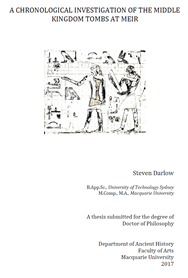
In the early to mid- Twelfth Dynasty, the provincial governors of the region downstream of Asyut developed a strong local culture, maintaining a degree of independence from the royal court that lasted until the reign of Senusret III. Located geographically in the middle of this group of four provinces is the fourteenth Upper Egyptian Nome, with the tombs of its governors situated in the necropolis of Meir. While the Meir tombs, along with the contemporary tombs of the other three provincial centres of Beni Hasan, Bersheh and Asyut have been the subjects of extensive prior study, aspects of the modes of artistic transmission between these provinces (and possible driving influences, including external factors) have not been fully addressed.
This thesis is arranged as a comparative chronological investigation, with the governors’ tombs at Meir as the primary focus, and the tombs of the governors of the neighbouring provinces making up the comparison sites. Contemporaneous tombs from other provincial sites and the royal courts of Western Thebes and Lisht are also included, for assessment of influences on Meir from these sources, as well as sources from earlier periods in Egyptian history (including Old Kingdom influences from Meir and the Memphite court and First Intermediate period / Eleventh Dynasty influences from various sites).
The chronological framework of the study is established from textual sources in chapter three, primarily relying on fixed dating via regnal references and relative dating via genealogical references. Other attributes of the tomb texts are investigated for their chronological dimension, confirming that changes in the phrases of the hetep-di-nesu formula established in prior studies are observed in the tombs of the study, and that epithets and titles of the tomb owner (with the exception of the title ‘Great Overlord of the N Nome’) are less variable from a chronological perspective.
Chapter four compares the architectural features of the Meir tombs with those of the comparison sites, with the finding that architectural styles are largely driven by local influences, but some common elements are identified which emphasise a longitudinal axis of orientation towards a cult focus (shrine) on the rear wall. Part two of chapter four compares the governors’ tombs at Meir with the burials of their direct subordinates (extended family and officials) by textual comparisons with the coffins from the lesser burials. Three distinct clusters of coffins are identified, with the names of the owners of the later group suggesting probable intermixing of individuals from this social class with their contemporaries from Beni Hasan (possibly via intermarriage and associated migration).
Chapter five compares the artistic styles and techniques observed in the Meir tombs with those of the comparison sites, noting that canonical techniques are universally applied, but are subject to local conventions and varying artistic capabilities. Case studies outline selected stylistic and compositional features of Meir tomb B2, highlighting the significant achievements of that particular artist in advancing the Meir artistic style from Eleventh and early Twelfth Dynasty royal styles, as well as the development of the artists’ grids through the Twelfth Dynasty as observed in tombs B2 and C1 (taking advantage of the unique existence at Meir of two chronologically separate tombs attesting surviving grids).
The iconography of the desert hunt and the tomb owner fishing and fowling is examined in Chapter six. Influences on the depiction of these themes at Meir are traced from royal and elite examples from the Fifth and Sixth Dynasty Memphite cemeteries, via the Sixth Dynasty tombs at Meir. Alignment of key attributes of these scenes are noted between Meir and all of the comparison sites towards the mid Twelfth Dynasty.
The data from the above analyses are synthesised in chapter seven, which illustrates points at which the paternal line of succession is interrupted at Beni Hasan and Meir, and similarities in how royal legitimacy was invoked at both sites to support the new incumbent. Routes of artistic transmission to and from Meir are presented for the iconographic themes of the desert hunt and the tomb owner fishing and fowling, demonstrating a tendency towards horizontal transmission processes which correlate with the evidence of intermarriage and migration between nomes during the Twelfth Dynasty, particularly noting evidence of this between Beni Hasan and Meir. Changes in technique can also be aligned chronologically with evidence of intermarriage and migration between nomes, particularly the change in technique in Meir tomb C1 from cut relief to purely painted representation (following the long-standing technique of artistic execution at Beni Hasan).

